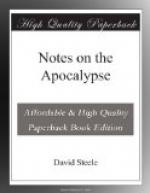17. And when I saw him, I fell at his feet as dead. And he laid his right hand upon me, saying unto me, Fear not; I am the first and the last:
18. I am he that liveth, and was dead; and, behold, I am alive for evermore, Amen; and have the keys of hell and of death.
19. Write the things which thou hast seen, and the things which are, and the things which shall be hereafter;
20. The mystery of the seven stars, which thou sawest in my right hand, and the seven golden candlesticks. The seven stars are the angels of the seven churches; and the seven candlesticks which thou sawest are the seven churches.
Vs. 17-20.—We have the effect of the vision upon the beloved disciple. He who had leaned on Christ’s bosom at supper, and who had seen his Master transfigured on the holy mount, was now utterly overwhelmed with the effulgence of his glory. John “fell at his feet as dead.” So it was with Daniel, “a man greatly beloved.” (Daniel x. 4-8.) But the compassionate Saviour dispelled his fears, as in all similar cases; making known to his astonished servant his supreme deity and real humanity, as “the first and the last,” who died for the sins, and was raised again for the justification of his people. (Rom. iv. 25.) He is “alive for evermore,”—become “the first fruits of them that slept.” (1 Cor. xv. 20.) He “dieth no more. Death hath no more dominion over him.” (Rom. vi. 9.) And so complete is his victory over the king of terrors, the last enemy of the believer, that he hath “the keys of hell and of death.” He has the “key of the bottomless pit,” (xx. 1;) having triumphed over principalities and powers, making a show of them openly. (Col. ii. 15.) Whether Christ used the word, “amen,” to ratify the truth of his immortality; or whether this is an expression by John of his joyful acquiescence in that truth, is not material: we know on satisfactory evidence, that our Lord is a prophet and king, as well as a priest, “after the power of an endless life.” (Heb. vii. 16; Rom. xiv. 9.)
John is next commanded to write,—First, “the things which he had seen;” that is, the description of the foregoing vision:—Second, “the things which are;” that is, the actual condition of the church, as delineated in the diverse characters of the seven churches addressed, as in the next two chapters:—Third, “the things which shall be hereafter:” that is, the prophetical part of the book, from the beginning




